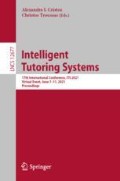Abstract
Children with autism spectrum disorder (ASD) are progressively acquainted with digital technologies in their training and diagnosis. Due to their growing accessibility and practicality, the potential should not be overlooked. Virtual Reality (VR) has become a noticeable tool to help children with ASD in their social training due to its competitive potential that provides extensive interaction, economical cost, safe environment and an enjoyable experience. The implementation of VR is often associated with heavy usage of head-mounted display (HMD) where through it, the immersive experience can be achieved. However this may not be applicable to children with ASD. Side effects such as motion sickness and claustrophobia may affect their training and performance. Therefore, this paper aims to present the development of non-immersive VR application with a serious game concept with inclusion of analytics, where progresses can be calculated, compared and observed. Upon post evaluation by experts, this game is improved and holds a larger potential to achieve its objectives.
Access this chapter
Tax calculation will be finalised at checkout
Purchases are for personal use only
References
Bradley, R., Newbutt, N.: Autism and virtual reality head-mounted displays: a state of the art systematic review. J. Enabling Technol. 12, 101–113 (2018)
Copeland, J.N.: What is autism spectrum disorder? Am. Psychiatr. Assoc. https://www.psychiatry.org/patients-families/autism/what-is-autism-spectrum-disorder (2018)
Dixon, D.R., Miyake, C.J., Nohelty, K., Novack, M.N., Granpeesheh, D.: Evaluation of an immersive virtual reality safety training used to teach pedestrian skills to children with autism spectrum disorder. Behav. Anal. Pract. 13, 631–640 (2019)
Halabi, O., El-Seoud, S.A., Alja’am, J., Alpona, H., Al-Hemadi, M., Al-Hassan, D.: Design of immersive virtual reality system to improve communication skills in individuals with autism. Int. J. Emerg. Technol. Learn. (iJET) 12(05), 50–64 (2017)
National Research Council: Educating Children with Autism. The National Academies Press, Washington, DC (2001)
Newbutt, N., Bradley, R., Conley, I.: Using virtual reality head-mounted displays in schools with autistic children: views, experiences, and future directions. Cyberpsychol. Behav. Soc. Netw. 23(1), 23–33 (2020)
Parsons, S.: Authenticity in virtual reality for assessment and intervention in autism: A conceptual review. Educ. Res. Rev. 19, 138–157 (2016)
Schwarze, A., Freude, H., Niehaves, B.: Advantages and propositions of learning emotion recognition in virtual reality for people with autism. In: Proceedings of the 27th European Conference on Information Systems (ECIS). AIS, Stockholm & Uppsala, Sweden (2019)
Simões, M., Mouga, S., Pereira, A.C., de Carvalho, P., Oliveira, G., Castelo-Branco, M.: Virtual reality immersion rescales regulation of interpersonal distance in controls but not in autism spectrum disorder. J. Autism Dev. Disord. 50, 4317–4328 (2020). https://doi.org/10.1007/s10803-020-04484-6
Acknowledgement
This study is funded by Fundamental Research Grant Scheme (FRGS) of Ministry of Higher Education, Malaysia (FRGS/1/2019/ICT04/MMU/03/12).
Author information
Authors and Affiliations
Editor information
Editors and Affiliations
Rights and permissions
Copyright information
© 2021 Springer Nature Switzerland AG
About this paper
Cite this paper
Rosli, M.I., Che Embi, Z., Abdullah, J. (2021). A Non-immersive Virtual Reality Application for Children with Autism Spectrum Disorder. In: Cristea, A.I., Troussas, C. (eds) Intelligent Tutoring Systems. ITS 2021. Lecture Notes in Computer Science(), vol 12677. Springer, Cham. https://doi.org/10.1007/978-3-030-80421-3_57
Download citation
DOI: https://doi.org/10.1007/978-3-030-80421-3_57
Published:
Publisher Name: Springer, Cham
Print ISBN: 978-3-030-80420-6
Online ISBN: 978-3-030-80421-3
eBook Packages: Computer ScienceComputer Science (R0)

